Partner: Karen Zhang
- CONTEXT AND SIGNIFICANCE
Our Midterm Project started from our discussion of the definition of interaction based on our experience in previous Group Project “Speaking Gloves”, and spread out as we moved forward to look for inspirations online.
I am particularly inspired by the artistic form of immersive theatre, represented by Sleep No More, where the audience are able to explore the space and settings to find material clues for the play. This provides me a subtle solution for a problem I met in my previous experience of designing interactive projects. I found the theatrical settings, if set cleverly, may give the audience more sense of participation on account of people’s natural absorption and processing of background stories and other information. This process is essential to our definition of interaction, which is a process composed of input, process and output of information of some complexity between two actors. Taking immersive theatre into my starting stage, I decided to do something involves theatrical elements.
However, our project had restriction in time and our technique, so we had to keep it practical. The most basic and primitive form of theatre that came to our mind was play house of children. Karen came up with the idea of role playing doctors, a typical profession that gets obvious input and output of information from medical tools. We found mant existing toys for children imitating medical activities mechanic and dull, so we decided to make a project that is interesting enough for children to have fun experience, and thus be encouraged to continue future exploration in medical field.
- CONCEPTION AND DESIGN:
Considering that our project targets mainly at children, we wanted to keep the input and output stage of interaction easy to practice and capture. Therefore, we chose one of the most directly reflective part in a medical check: taking the heartbeat with a stethescope. The input can be achieved with touching, a simple body engagement, while the output takes form in sound. To make the output of information more explicit and complex, I came up with the idea that we can also give visual output with blush on the face of the “patient”. For these “blushes”, we thought the conbination of 3D printing products and LEDs would be the most convenient way for us to produce.
We also wanted to create fun elements, even games, in our project to keep our audience interested. So we made up a background story: An alien whose spacecraft crashed on earth needs an urgent body check, but we human beings know nothing about his body and need to search for the location of his heart(s). We planned to introduce this plot to our audience in performance.
In addition, we wanted the subject of our project cute, welcoming and “toucher-friendly” enough to the audience. Considering all factors above, we purchased a plush toy online to be our subject because of its softness and cuteness. Of course, we also got a real stethoscope vital to the role play.
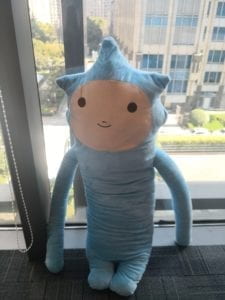
- FABRICATION AND PRODUCTION:
We started with the sensors. After testing several kinds of sensors, we decided that a pressure sensor in the style of a belt suits our project best. It was large enough in scale for participants to find. We planned to connect it with arduino that controlled two red LEDs and a speaker, and then plant them into the body of the alien doll, so that the lights in the “blushes” and speaker will work when the doll is stroked. When building the circuit, we got help from Nick.
 The sample diagram drew by Nick.
The sample diagram drew by Nick.
We encountered several failures in 3D printing the LED shells. We originally intended to construct two translucent shells, but the products failed to meet our expectation for three times, because this shape is difficult for the 3D printer to accomplish. So we redesigned the shells into semi-hollow cylinders, which is easier to make.
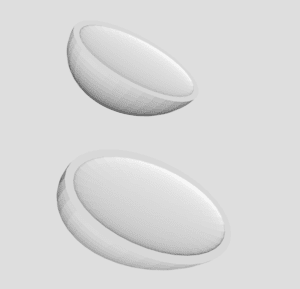 Our original design that failed.
Our original design that failed.
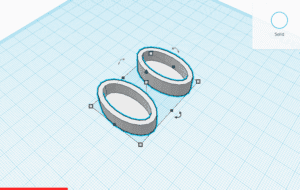 Our final design.
Our final design.
We assembled the shells and the LEDs before cutting the doll open to plant them in.
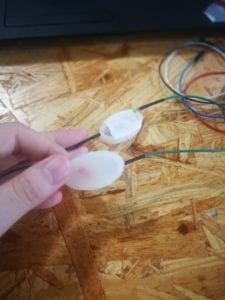 Assembling the “blushes”.
Assembling the “blushes”. 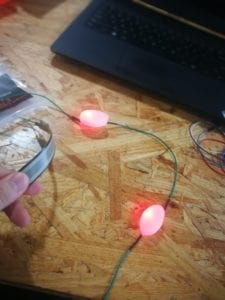 Imitation of blushes with lighted red LEDs
Imitation of blushes with lighted red LEDs
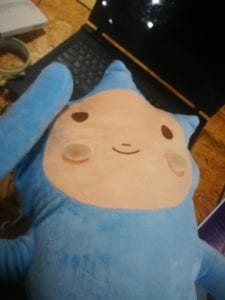 Inserted into the doll
Inserted into the doll
For the sound output, we first intended to use an MP3 arduino shield o play a sound clip of heartbeat according to the suggestion of Eric. But we found the shield not usable unless we soldier the wires, which was too time- and energy-consuming. So we switched to use a buzzer and composed a simple tune in vcc file. This worked, but we were not satisfied with the situation that we cannot play soundclip of heartbeat.
The sound of heartbeat is so vital to the clarity of our project, so we again made another adaption. We tried using an MP3 player, and finally succeeded in playing the soundclip with help of Erik.

The final code for our arduino
So far, our project had completed the first stage of construction. When the doll is stroked in certain areas with enough pressure, the pressure sensor underneath its skin will send the data to the arduino, which controls the LEDs and the MP3 player to work. The sound was amplified through two loudspeaker boxes placed outside. Then we attended the user experience test with this project, and named it HeartbE.T.
During the test, we received many useful thoughts and suggestions. The one that influenced our project most was that it was too confusing for the participant not to hear the heartbeat through the stethoscope. Also, some participants pressed less hard than enough so they did not activate the sensor at all.
The users found it difficult to locate the correct position, or even got confused at what to do.
To fix these problems, we connected the MP3 player to a headphone instead of the speaker boxes, and sticked the headphone wire with the stethoscope. Therefore, the participants would be able to get more convincing feedback from the headphone. We also slightly adapted our code to make the sensor more sensitive. We once thought of replacing the pressure sensor with a magnetic one, but we gave up that because magnetic sensors were too small to find in such a large doll.
For our last performance, we improved our story, adding more details and background information to it. We made files for the crashed spacecraft in the story, and designed a poster for our project. These actions turned out to be quite successful in the ultimate presentation: Though our audience at the presentation were all adults, they thought the story interesting and the theatrical performance important to the interactive experience. To add the degree of interaction, we provided stickers for the participants to mark out the location of the heartbeat they capture.


My demonstration of the project
- CONCLUSIONS:
The participants smoothly figured out how to interact with our alien HeartbE.T. in a short time with the tailor-made “stethoscope” and our introduction of the story, though one of them met a little difficulty in finding the locations because of the problem of lacking pressing power, which we intended to fix after the user test.
I managed to include theatre and performance elements in our project to increase the participants’ sense of engagement, which was successful. The participants commented the project as interesting, engaging and inviting (in the sense of loveliness). However, according to the feedback we received at the final presentation, the “final goal”, or the “reason” for the project itself does not seem very clear to the audience. They were invited to participate in the story, but they had no understanding why they should do it. As a result, they did not get a sense of “final reward” after finishing their experience. In other words, while I focused on the instant output/feedback, I actually neglected the sense of overall accomplishment which a complete interactive project should have. The theatrical element played a role, but it can still be improved on the level of completeness.
If I have more time on the project, I would like to find out a way to make up for the shortness of pressure sensors. I think adding a final reward at the end of the interaction process would also help a lot, for example, a signal showing the alien coming back to life. This relates again to the completeness of the story which I would like to polish to cater to the improved project. Besides, since our original target audience are children, I would like to invite some children to play with the project and provide feedbacks. If possible, I will be able to adapt it into a version that considers more about children’s ability of learning and understanding.
The interactivity in our project relates closely to our goal: to encourage learning through fun activities. In interactive process, participants experience fun through thinking/processing information and getting right feedback. It is this reasoning of positive learning that the most precious part I have taken from the project.
References
Sleep No More: http://mckittrichotel.com
Doctor play house: https://slate.com/human-interest/2018/09/best-doctor-kit-toys-toddlers-older-kids.html
source of document making: https://vault.fbi.gov/UFO/UFO%20Part%202%20of%2016/view